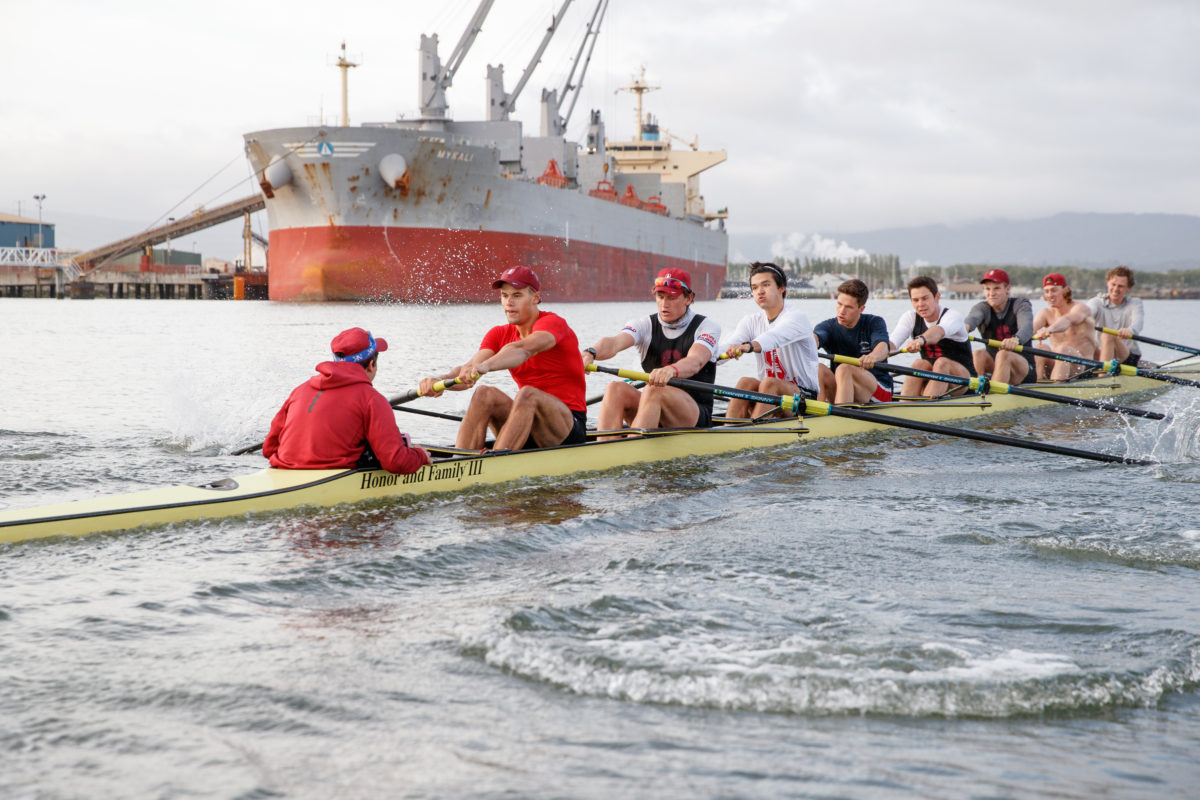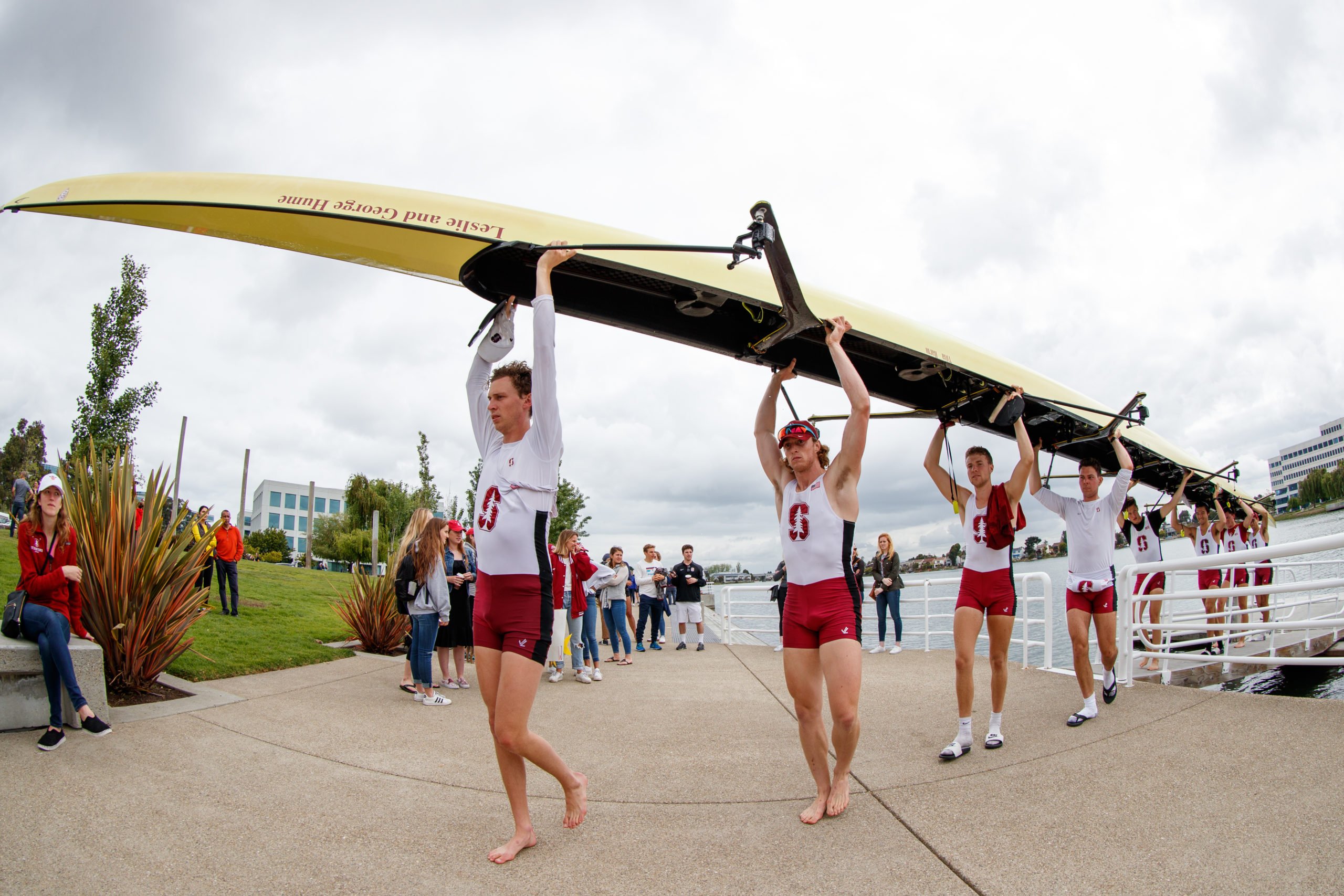“Upstream battle” is a series documenting the reactions of current athletes and alumni to the University’s announcement on July 8 that it would discontinue men’s rowing and 10 other sports. Part one on athlete reactions can be found here.
Men’s rowing at Stanford has always been the sport of opportunity. Any student, even one with no prior rowing experience, has the opportunity to walk onto the team, provided they are willing to wake up before 5:30 a.m. most mornings for practice and embrace the grueling year-round training. While other sports also hold open tryouts to accept walk-ons, rowing is unique in that many former walk-ons, including some who learned to row at Stanford, have excelled throughout their professional careers — even competing in the Olympics.
These unique athletic opportunities made the University’s decision to cut the sport all the more devastating to current athletes and alumni, who fear that the impending discontinuation will deny future student-athletes the chance to learn and excel in the sport.
Martin Amethier ’20, a co-captain during his senior year, walked onto the team as a freshman. He rowed briefly in high school but gave up the sport after a few years to pursue basketball.
He changed his mind, however, when a Stanford dormmate on the rowing team encouraged him to try out because the team was looking for “tall walk-ons.”
“Then I just caught the bug,” Amethier said.
The success stories of past walk-ons motivated Amethier to continue rowing with the team. As a junior in 2019, he was named to the All-Pac-12 team and was a member of the Varsity Eight that placed 10th at the national championship.
The team is “such an unbelievable group of people … that I wouldn’t have otherwise met and called my closest friends,” he said. “It’s been an unbelievable experience for me, and I really hope that other people can have that same experience.”
Jason Lupatkin ’13 also walked onto the team as a freshman with no rowing experience after playing basketball and baseball in high school. He earned a scholarship by his senior year.
Lupatkin said a rower approached him in a math class, noted that he was tall and asked if he wanted to try out for the team.

He first learned to row on the erg, an indoor training machine, then transitioned to learning how to row a boat on the water. He said that as walk-ons improve on the erg, they receive more opportunities to row on the water with the more experienced athletes.
“I found my best friends, my community right at Stanford [rowing],” Lupatkin said. “There’s no difference on the team between the recruits and the walk-ons. It becomes this really close-knit group of guys to the extent where it becomes one family.”
Racial and gender diversity
The University stated that one of the criteria it used to choose the 11 sports cut was “impact on the diversity of our student-athlete population.” Stanford’s tradition of taking walk-ons, however, made the sport accessible to athletes who may not have had the opportunity to row before college.
“Stanford is in this special position where we have the opportunity to be a leader in the sport which has a background of privilege,” said Austin Hack ’14. “I’m optimistic that we can seize that opportunity, and I would be really disappointed if this is something Stanford passed on.”
According to USRowing, only 1.3% of the 75,000 high school and college rowers in 2019 identified as Black or African-American. Of the three Black male rowers who have represented the United States in the Olympics, two rowed for Stanford: David Banks ’05 M.S. ’06 and Alex Osborne ’09, both of whom joined the Cardinal as walk-ons.
Banks, a high school track runner and basketball player, told World Rowing in 2013 that he originally planned to walk on to Stanford’s track team. After attending the first rowing practice with a friend who was a team member, however, Banks was drawn to the passion of former head coach Craig Amerkhanian and assistant coach Jon Allbin.
In 2008, Banks was selected for his first U.S. Olympic Team and finished ninth in the 4- in Beijing. He also competed in the men’s 8+ in the 2012 Olympics, where the U.S. team finished fourth.
Osborne, a high school basketball and golf player, followed a path similar to Banks’s at Stanford.
“When I first met Craig Amerkhanian and Jon Allbin I was immediately sold on rowing,” Osborne told row2k in 2012.
Banks was pursuing his master’s degree at Stanford when Osborne joined the team in 2005, and Osborne said “watching how [Banks’s] dedication paid off really served as the model of excellence that I want to follow.”
Osborne ultimately did follow in Banks’s footsteps and competed in the men’s quadruple sculls at the 2012 Olympics.
Amethier, who now lives in Sweden and whose grandfather is from the Ivory Coast, called the stories of Banks and Osborne “inspiring” to his rowing journey at Stanford.

The co-ed nature of the team is also unique among men’s sports at Stanford, and stands out to Trey Holterman ’21. He is working towards a degree in computer science and will co-captain the team next year with Nikita Lilichenko ’21.
The team currently includes female coxswains Paige Warmington ’22 and Valeria Gonzalez ’23. Coxswains ensure that the rowers are working in sync, steer the boat and provide encouragement and motivation to the athletes who are rowing.
The required weight maximum for collegiate men’s rowing coxswains is 125 pounds. While most adult males are not small enough, many young women — who would not have otherwise had the chance to compete in a collegiate men’s sport — are encouraged to try out. It is common among college programs to have multiple females for the coxswain position, and top programs, including Harvard and Washington, also have co-ed rosters.
“It’s like we have sisters,” Holterman said. “I’m a part of a big family, and all the boys in the family wouldn’t be as good if we didn’t have sisters.”
Effort, not talent, equals success
“There’s a much higher correlation between effort and success than there is between talent and success [in rowing],” said Bart Scherpbier ’19. “At the end of the day, when you look at your results, it’s a really honest reflection of the decisions you’ve made and the actions you’ve taken, and how that has defined results. That was a really vital lesson for me to learn at Stanford.”
Holterman is currently working at Strava, where he was able to speak with two coworkers who are former Harvard rowers.
“They said that nothing that they learned in school prepared them in the way that rowing did, so you simply can’t make an argument that it’s not worth having,” he said. “The reason it’s so good, the reason it’s so useful and so beneficial, is because rowing, to really extract all that it can, requires the feeling that you can compete at the highest level — the feeling that you can give everything and, in return, get something back on that investment.”
Other rowers also pointed to that process, which Holterman said has been “proven time and time again to produce amazing people.”
“I don’t think there is a better subset of the population that is consistently turning out excellent, hardworking, caring, loving men than the men’s rowing team,” Holterman said.
Lupatkin called rowing “self-empowering” and said that it taught him discipline that has extended to other aspects of his life. By cutting the team, the school “loses an opportunity to develop the next generation of highly intelligent and well-rounded leaders,” he said.
“They lose the opportunity to develop tough, hardened, gritty individuals,” Adam Kreek ’07 said in agreement. “Rowing is a coming-of-age event for many young men and women that have to cross the threshold of pain, self-doubt and exhaustion. And when they get to the other side, they come out stronger, they come out more determined and they come out more able to face the challenges of life.”
At least one athlete has indicated that he intends to transfer to a different university, and another is taking a gap year, forgoing Stanford’s final season, to weigh his options and explore different paths forward. The consensus among the athletes and alumni is that many rowers on the current team may transfer after 2021 if the varsity team is demoted to the club level.

Scherpbier said that cutting men’s rowing and 10 other sports could also be detrimental to the remaining 25 sports. Along with working out together in the weight room, Scherpbier said he and his student-athlete friends would discuss leadership approaches by coaches and athletes in their respective sports. They would then bring those unique methods and skills back to their teams.
“The sports at Stanford really feed off each other,” he said.
Academically driven athletes
The rowing team has a tradition of notable academic and athletic achievements. The current team’s average GPA is 3.7, and according to the 2019-2020 roster, and over 50% of declared student-athletes were working toward degrees in computer science, engineering, math or a related field.
“Our old coach [Craig Amerkhanian] was always screaming at the top of his lungs, ‘6’5” and 35 ACT,’” Holterman said. “There’s nobody that snuck their way into the school.”
Lupatkin said that cutting sports like rowing will create a wider divide between the student-athletes who are working toward professional athletic careers and student-athletes who know there are no high-paying professional athletic opportunities in the future. He said that rowing and most of the other sports that will be cut bridge the gap between the future professional athletes and the general student population.
Many rowers are also involved in the Stanford community as a whole through TA positions, fraternities and other student organizations.
Although professional opportunities for rowing are few and far between and do not offer multi-million dollar contracts, the Cardinal are well-represented on the Olympic podium. Eight men’s rowing alumni have combined to win 10 gold medals since 1956. Most recently, Kreek won a Gold medal for Canada in 2008.
Despite the lack of financial incentive, many rowers said they continue rowing out of love for the sport.
“Every rower who does it thinks, why am I doing this? I need to quit,” Kreek said. “There’s something better I should be doing. For some reason [we] stick through and get to the end. That’s the magic that’s created with the sport of rowing.”
“The values, the lessons, the friends that I made in rowing will supersede everything else,” Holterman said.
Amethier and Holterman both plan to continue their rowing journeys after Stanford. Both said that they hope to pursue graduate degrees at universities where they can continue rowing. All members of the 2019-20 roster have received an additional year of eligibility due to COVID-19 spring cancellations.
Despite planning for the future, Holterman and other rowers have not yet given up on the Stanford program.
“The coldest part of the night is right before the sun comes up, right before you’re about to accomplish your biggest goals,” Holterman said. “I think this is just one of our last tests. We’re going to overcome it, and we’re going to win a national championship.”
Contact Sofia Scekic at sscekic ‘at’ stanford.edu and Karlaine Francisco at itskarlaine ‘at’ gmail.com.
